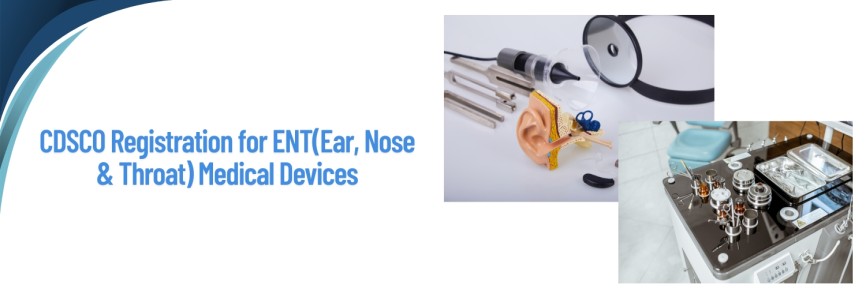In India, medical devices such as those used for Ear, Nose, and Throat (ENT) treatments are regulated under a strict licensing framework governed by the Central Drugs Standard Control Organization (CDSCO). This regulatory body ensures that all ENT medical devices manufactured, imported, sold, or distributed in the Indian market meet safety, quality, and performance standards. Manufacturers, importers, and authorized agents must obtain CDSCO Registration For ENT Medical Devices before launching these products in the market. This article explains the entire process, documentation, and compliance requirements in detail.
What are ENT Medical Devices?
ENT Medical Devices are instruments, tools, or implants used to diagnose, treat, or manage conditions related to the ear, nose, throat, and associated structures in the head and neck. These devices are often used by medical professionals, especially otolaryngologists, in both outpatient and surgical settings. Common ENT devices include otoscopes, nasal speculums, hearing aids, and surgical instruments for procedures involving the larynx, sinuses, or ear canal.
What is CDSCO and Its Role in Medical Device Regulation?
The Central Drugs Standard Control Organization (CDSCO) functions under the Directorate General of Health Services in the Ministry of Health and Family Welfare. It is India's national regulatory body responsible for ensuring the quality, safety, and efficacy of medical devices, pharmaceuticals, and cosmetics. Under the Medical Devices Rules, 2017, CDSCO classifies medical devices into Class A (low risk), Class B (low-moderate risk), Class C (moderate-high risk), and Class D (high risk). It grants licenses, monitors manufacturing and import practices, ensures post-market surveillance, and enforces compliance through audits and reports. CDSCO Registration For ENT Medical Devices is mandatory for legal sale and distribution in India.
Importance Of CDSCO License for ENT Medical Devices
CDSCO Registration for ENT Medical Devices is important for several reasons. Firstly, it ensures that patients are protected by allowing only tested and compliant devices to enter the Indian healthcare system. Secondly, it guarantees that the manufacturers and importers follow the rules set forth in the Medical Devices Rules, 2017. Thirdly, it enables the smooth entry of products into the Indian market and ensures they meet quality benchmarks.
Additionally, licensed devices gain credibility among healthcare providers and patients, and they also enjoy higher acceptance in international markets. Manufacturers that operate under a CDSCO license are encouraged to innovate while maintaining compliance, helping them introduce new and safe ENT technologies. Moreover, CDSCO licensing is a preventive step against legal liabilities that may arise from non-compliance or faulty devices.
Types of ENT Medical Devices Covered by CDSCO
CDSCO regulates a wide range of ENT medical devices based on their usage and the level of associated risk. These include:
-
Hearing Aids: Used to amplify sound for individuals with hearing loss.
-
Cochlear Implants: Surgically implanted devices for those with severe hearing impairment.
-
Nasal Cannulas and Oxygen Masks: Devices for oxygen delivery in respiratory treatments.
-
Endoscopes: Instruments for internal examination of the nasal or laryngeal regions.
-
Surgical Instruments: Tools like forceps, speculums, and otoscopes for ENT procedures.
-
Tympanostomy Tubes: Small tubes inserted into the eardrum to allow drainage.
-
Diagnostic Devices: Such as audiometers and tympanometers used in hearing tests.
These devices fall under various classes (A, B, C, and D) depending on their risk profile and are regulated accordingly.
Who Can Apply for CDSCO Licensing for ENT Devices?
CDSCO Registration for ENT Medical Devices can be applied for by the following entities:
-
Manufacturers: Companies that manufacture ENT medical devices in India must register with CDSCO and meet the required quality standards under ISO 13485.
-
Importers: Those bringing devices from other countries must obtain CDSCO import licenses. They must appoint an Authorized Indian Agent.
-
Authorized Indian Agents: These representatives act on behalf of foreign manufacturers to handle the application process, liaison with CDSCO, and post-market compliance.
-
Distributors (in rare cases): If allowed under the law and with valid authorization, distributors can also apply for registration.
Documents Required for CDSCO Registration for ENT Medical Devices
-
Application Form (Form MD-3/MD-7): As applicable for manufacturing or import.
-
Device Master File (DMF): Details about the device's specifications, intended use, design, and labeling.
-
Plant Master File (PMF): Information about the manufacturing site, technical staff, and facilities.
-
ISO 13485 Certificate: Demonstrates adherence to quality management systems.
-
Free Sale Certificate (FSC): For imported devices, issued by the regulatory authority in the country of origin.
-
Clinical Evaluation Report: Data showing the safety and effectiveness of the device.
-
Risk Management Report: Prepared as per ISO 14971 to identify and mitigate potential risks.
-
CE Design Certificate: For devices already certified in European markets.
-
Labelling Details: As per Drugs and Cosmetics Act, 1940 and MDR, 2017.
-
Undertaking Letter: Declaration of the authenticity of submitted data.
Step-by-Step Process to Apply for CDSCO Registration for ENT Medical Devices
Step 1: Classification of Medical Devices: The first step is to classify the ENT medical device according to risk. Class A and B devices are considered lower risk and are regulated by the State Licensing Authority (SLA), while Class C and D devices are regulated by the Central Licensing Authority (CLA).
Step 2: Registration on CDSCO SUGAM Portal: Next, applicants must register on the CDSCO’s SUGAM portal. This online system allows submission and tracking of applications. Registration involves creating a user ID, filling out company and product details, and uploading basic documents.
Step 3: Preparation of Documents: A range of documents must be prepared, including the Device Master File (DMF), Plant Master File (PMF), ISO 13485 certification, CE design certificate (if applicable), clinical evaluation data, and a Free Sale Certificate (FSC) for imported devices. These documents provide technical and safety information about the device and manufacturing setup.
Step 4: Filing the Application: The application form—either Form MD-3 or MD-7—must be submitted depending on whether the device is manufactured or imported. All required documents must be uploaded, and the relevant fee must be paid through the SUGAM portal.
Step 5: Review by CDSCO: The CDSCO authority examines the application and may request additional data or documents. In some cases, a physical inspection or audit of the manufacturing site is conducted to verify compliance.
Step 6: Issuance of License: Upon satisfaction with the submitted documents and inspection, the CDSCO issues the appropriate license (e.g., MD-5, MD-9, or MD-15) that permits the manufacturer or importer to legally market the ENT medical device in India.
Renewal of CDSCO License for ENT Medical Devices
CDSCO licenses are typically valid for five years. Renewal applications must be submitted before expiration—generally 90 days in advance for manufacturing licenses and 6 months for import licenses. No additional documents are required beyond updated DMF and PMF, but all submitted information must be accurate and up-to-date. Failure to renew on time can lead to license expiry and interruption of business operations.
Penalties for Non-compliance
Non-compliance with CDSCO regulations can lead to severe consequences including:
-
Suspension or cancellation of license.
-
Financial penalties and fines.
-
Criminal prosecution in case of serious violations.
-
Confiscation or recall of the product from the market.
Manufacturers and importers are advised to strictly adhere to guidelines to avoid such actions. Regular audits and documentation checks are conducted to ensure ongoing compliance.
Conclusion
CDSCO Registration For ENT Medical Devices is a mandatory process that ensures product quality, safety, and legality in India. From classification and documentation to submission and licensing, every step must be diligently followed. Whether you are a domestic manufacturer or an importer, getting your ENT devices licensed under CDSCO is essential for entering and thriving in the Indian healthcare market. Proper compliance will not only secure your product’s place in the market but also enhance its credibility and consumer trust.
If you need any further assistance in CDSCO Registration for medical devices, cosmetics, and drug-related products then you can book a free consultation with our experts through email info@ccoffice.in or Call/Whatsapp at +91 9988424211.
Frequently Asked Questions
Q1. What is the validity of the CDSCO license for ENT devices?
Ans. CDSCO licenses are generally valid for 5 years from the date of issuance.
Q2. Can foreign manufacturers apply for CDSCO registration directly?
Ans. No, they must appoint an Authorized Indian Agent who is licensed in India.
Q3. What happens if I fail to renew my CDSCO license on time?
Ans. You may lose the legal right to manufacture or import the device until the license is renewed.
Q4. Are all ENT medical devices regulated by CDSCO?
Ans. Yes, especially those notified under MDR, 2017. Devices are categorized by risk.
Q5. Is CDSCO license mandatory for Class A and B devices?
Ans. Yes, from October 1, 2022, Class A and B devices also require CDSCO registration.
Q6. What is the purpose of the Device Master File (DMF)?
Ans. It provides technical, safety, and usage information about the device.
Q7. What is ISO 13485?
Ans. It is an international standard for quality management systems specific to medical devices.























_crop10_thumb.jpg)
_crop10_thumb.jpg)



_crop10_thumb.jpg)








_crop10_thumb.jpg)























2018_learn_crop10_thumb.jpg)



